|
Related FAQs: Wrasses, Wrasses 2,
Wrasse Identification, Wrasse ID
2, Wrasse Behavior,
Wrasse Selection, Wrasse Compatibility, Wrasse Systems, Wrasse Feeding, Wrasse Disease, Wrasse Disease 2, Wrasses & Crypt, Wrasse Reproduction,
Wrasse Regional Accounts:
Cook Islands, Wrasses Found in Indonesia Part One,
Two, Three,
Wrasse Articles/FAQs on:
Ideal Wrasses To
Keep in Marine Aquariums
by Bob Fenner,
Anampses, Hogfishes/Bodianus, Maori Wrasses/Cheilinus & Oxycheilinus, Choerodon/Tuskfishes, Harlequin Tuskfish/Choerodon fasciatus,
Fairy/Velvet Wrasses/Cirrhilabrus, Coris
& Coris gaimard, Bird Wrasses/Gomphosus, Halichoeres, Cleaner Wrasses/Labroides, Tubelip Wrasses/Labropsis,
Lachnolaimus, Leopard Wrasses/Macropharyngodon, Oxycheilinus, Pencil Wrasses/Pseudojuloides, Razorfishes, Dragon Wrasse, Paracheilinus, Pseudocheilinus, Stethojulis, Thalassoma,
The Best Livestock for A Marine Aquarium
The Wrasses, Family
Labridae
|
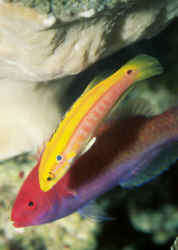
|
|
by Bob Fenner
|
Cirrhilabrus,
Bodianus
|
The Wrasses constitute one of the largest (the second
largest family of fishes (after the Gobies with at least 60 genera and
six hundred plus species.) and most diverse families of marine fishes.
From amongst the smallest (Minilabrus striatus of the Red Sea at
under two inches and part of an ounce) and largest (the Napoleon
Wrasse, Cheilinus undulatus at more than seven feet and four
hundred pounds) of species, they are plain to outright gaudy in their
markings and coloration, easygoing to the point of total
non-competitiveness to true terrors of the reef. (Labrid fishes are
found in shallow waters, tropical to semi-temperate, worldwide with the
exception of the Arctic and Antarctic seas).
Their usefulness and survivability as aquarium species
and specimens parallels their size, structural and color diversity.
Some rarely live at all under captive conditions, others you have to
literally "beat with a stick" (or leave an opening at their
tank top for them to jump out) to kill. Quite a few of the species
offered in the trade have specialized "social" needs,
requiring others of their kind, lots of hiding spaces, soft sand to
burrow and bury in, easygoing tankmates, and dedicated feeding. On the
other hand, this family contains some real aquarium stalwarts that do
well under the broadest of reasonable conditions.
Many Wrasse genera, comprise several (from the Middle
English meaning "many") other species than listed here that
might, would, will make suitable aquarium specimens, but have yet to
make their way into pet-fish markets. Much of this "lack of
use" is a function of ignorance ("I don't know they
exist, so why would I ask for them?"), and poor infrastructure
(e.g. no airline service to/out of the area they're found in). As
time goes by there will continue to be new offerings assuredly.
Here is my rundown of the genera and species of wrasses
that are used (and others that should be) by the aquarium interest,
with a ranking of their relative/historical likelihood of staying alive
in your system, with some pertinent notes on their selection, husbandry
and natural history.
Captive Suitability Scoring:
After long thought, investigation of others declared
opinions, and handling thousands of these fishes over the last thirty
some years in the trade I've come up with the following scheme of
"scores" for each on its likelihood of surviving the rigors
of aquarium care. To a degree this information is necessarily
historical (what has happened, may not be the general trend to come),
and is subject to "improvement" on the keepers side as a
consequence of providing larger, more stable quarters and more diligent
husbandry. But, by and large a relative score of one (1)
indicates the "highest and best" survivability under captive
conditions; let's say most of the specimens of this species
collected surviving more than three months. A score of two (2)
is indicative of a mortality of more than fifty percent between one and
three months. Lastly, and sufficient for our purposes, a three
(3) is the worst score, with more than 50% of the species
perishing before a months time of capture. I entreat you to leave the
latter group to the sea, or at least to study and provide the best
possible circumstances for these animals.
I'm aware that other authors, even highly respected
scientists' ratings are different than those stated here. And that
your dealer's) probably consider my "judgments" too
harsh. My advice is indeed, not to rely on what's stated here
and/or any one other source of information. Before purchasing these (or
other livestock) do your best to gather as much pertinent
"accurate, significant, and meaningful" information as you
can from reading, other hobbyists and the industry.
For coverage of genera and groupings, click on the
blue-highlighted names.
|
Genus Anampses: The touchy
Tamarins.
|

|
|
Genus Bodianus
& Lachnolaimus: The Hogfishes
|
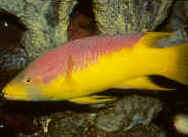
|
|
Bulbometopon muricatum, the Bumphead Wrasse... second in size only
to the Napoleon... |
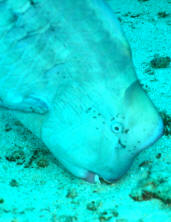 |
|
Genera Cheilinus &
Oxycheilinus: The Maori or Splendour Wrasses
|
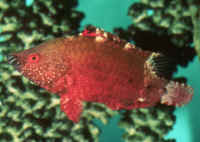
|
| Genus
Cheilio: I'll mention the seagrass-dwelling Cigar Wrasse,
Cheilio inermis (Forsskal 1775) (3), only because it
occasionally is offered in pet-fish markets, and rarely lives in
captivity. Indo-Pacific, including the Red Sea, out to Hawai'i.
To twenty inches in length. At right: one in the Gilis, Indonesia
in a typical flanking behavior, disguised with a Goatfish. Below:
Three color varieties in S. Sulawesi. |
 |
Bigger PIX:
The images in this table are
linked to large (desktop size) copies. Click on
"framed" images to go to the larger size. |
|
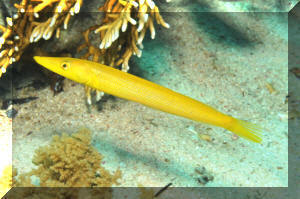
|
|
|
Genus
Choerodon: Harlequin Tuskfish
(Choerodon fasciata), nineteen species in this genus.
|
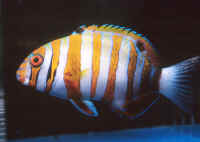
|
|
Genus
Cirrhilabrus: The Fairy or Velvet Wrasses
|
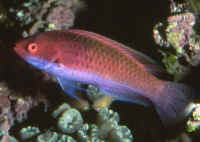
|
|
Genus Clepticus: Here is another species
we?ll mention, the Creole Wrasse, Clepticus parrae (Bloch
& Schneider 1801) (3), simply because it (mis)enters the
trade from time to time. This reef roamer is not often identified
as a wrasse at all, as it cruises above the reefs of the tropical
western Atlantic. The Creole Wrasse almost always dies in route
from being shipped from the wild. To one foot in length. This one
in Cancun, Mexico.
|
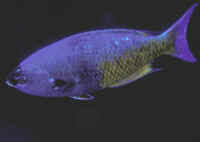
|
Bigger PIX:
The images in this table
are linked to large (desktop size) copies. Click on
"framed" images to go to the larger size. |
%20MD.jpg)
%20MD.jpg)
%20MD.JPG)
%20MD.JPG) |
|
|
Genus Coris:
including a species article on: Coris
gaimard
|

|
|
Genus
Diproctacanthus: One species; Diproctacanthus
xanthurus (Bleeker 1856), the Yellowtail Tubelip Wrasse. |
|
Doronotonatus megalepis Gunther 1862, Dwarf Wrasse. To three
or so inches in length. Here a two incher hides in shallow eel
grass bedding in Cozumel. Found in the eastern and western
tropical Atlantic. |
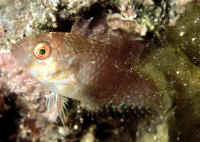
|
|
Genus Epibulus: The Sling-Jaw Wrasse,
Epibulus insidiator (Pallas, 1770) is showing up more and
more in the industry, and is a real winner looks-wise, though
I'll still have to rate it a moderate score (2) in historical
hardiness. Below: Juvenile with distinctive markings, females are
golden yellow over-all, while males are blackish in the back,
pale on the face, with an orange-brown "coat" on their
back. To fourteen inches total length. Indo-Pacific.
Sling-Jaw Wrasse. Discerning Epibulus spp.
5/28/16
Hi Guys
I have been trying to find a definitive answer to identifying the
differences between the two Sling-Jaw Wrasse species, Epibulus
insidiator and Epibulus brevis but keep finding contradictory
information. I have gathered that there are differences in colours as
they mature within each species and between the species but am not
completely sure what these are. The reason I ask is that there is a 3.5"
Sling-Jaw at my local fish shop but I don't know which species it is.
<Almost all specimens sold in the trade are E. insidiator. Oh, this
lifted from FishBase re E. brevis: This species is distinguished from
its only congener Epibulus insidiator by the relatively drab coloration
of the male; a prominent black pigment on the pectoral fins of most
females (vs. absent); smaller size with slightly longer pectoral fins">
It changes colour frequently from a grey-brown to much lighter version
of this (I assume depending on its mood) and as it is the only one of
its genus present I am unable to compare it with any others of similar
size for differences.
<Look for the dark pectoral fin base....>
I am looking to add a Epibulus insidiator to my aquarium so would like
to make sure I buy the correct species. I hope you can help me with this
and I appreciate your time!
Many thanks,
Jake
<See the pix on FB... The two species are rather distinctive. Bob
Fenner>
|
 |
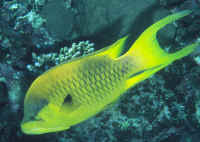 |
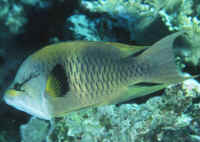 |
Bigger PIX:
The images in this table are
linked to large (desktop size) copies. Click on
"framed" images to go to the larger size. |
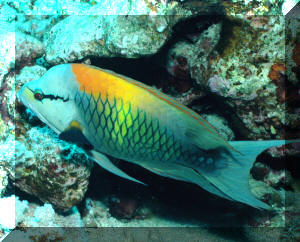
%20MD.JPG) |
|
|
Genus
Gomphosus: The Bird Wrasses
|

|
|
Genus
Halichoeres: Halichoeres A-M, Halichoeres N-Z
|
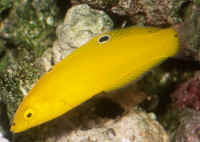
|
|
Hemigymnus &
Hologymnosus Genera Wrasses: |
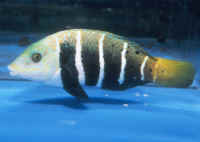 |
| Genus
Hemipteronotus: part of the Razorfishes, See genus Novaculichthys. |
| Genus Labrichthys: The sole
member of this genus is the Tubelip Wrasse, Labrichthys
unilineatus |
|
Genus
Labroides: Cleaner Wrasses
|

|
|
Genus
Labropsis: Tubelip Wrasses
Labropsis xanthonata, stkg./sel.
2/18/12
Hi Bob,
<Chris>
I hope that all is well! Labropsis xanthonata - what's
the consensus on the species being reef safe (more concerned
about SPS munching)?
<May eat Acropora polyps as adults; and is a touchy genus,
species to keep... Not a good shipper>
I have not found much info on them online in this
regard.
<Sold off and on in the trade... a beauty>
Many thanks,
Chris
<Welcome. Bob Fenner>
|
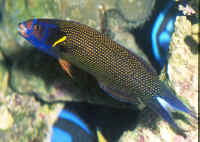
|
|
Genus
Lachnolaimus: Another " Hog" genus and this one's
really more of a pig than any of the Bodianus species.
Lachnolaimus maximus, is THE Hogfish (2) in the tropical
western Atlantic. A beauty when small (most offered in the trade
at 6-8 inches) but quickly grows BIG (to thirty-two inches in the
wild!). A shy giant that often comes in too beat to acclimate to
captivity.
|
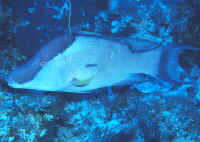
|
|
Genus Larabicus: Larabicus
quadrilineatus (Ruppell 1835)(2), the Fourline or Arabian
Cleaner Wrasse is actually a cleaner only as a juvenile. As
adults (they only get to five inches) the Fourline Wrasse mainly
feeds only on coral polyps. Occasionally imported from the Red
Sea. Also found in the Gulf of Aden to the south. Adult/male and
female shown. Males dark blue in color overall.
4 striped wrasse cocoon, Cleaner wrasse in
nocturnal "cocoon" - 7/23/07 <<interesting...
don't know that I've ever heard of a Cleaner Wrasse
(likely a Labroides) exuding a sleeping cocoon, though many
wrasses and Parrotfishes do... And there are a bunch of organisms
that might use such feeding techniques that might render your
observation... And it does sound like there is a
"mystery" culprit in your tank... but who? A sea
cucumber? Large polychaete worm? Bob Fenner>> i was
rearranging the rockwork in the morning right after I turned the
light on in my refugium... the blue 4 stripped wrasse wasn't
out yet, but when I moved one of the rock he came bolting out of
what was a mucus cocoon, usually I find him sleeping in the
smallest crevises of the LR but ive never seen anything like
this... just thought id confirm that Larabicus quadrilineatus can
and do sleep in mucus cocoons. though I don't think they
'prefer') as I've been moving his 'sleeping'
spot everyday for 2-4 days now (he got moved to sump after eating
SPS).. bastard...anyway...good day. -Devon sorry no spell check
or punctuation. <Thank you for this input. Bob Fenner>
|
|
Bigger PIX:
The images in this table are
linked to large (desktop size) copies. Click on
"framed" images to go to the larger size. |
|
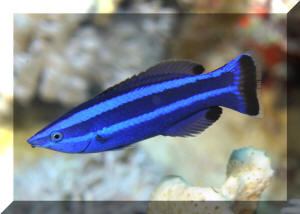
|
|
| Genus
Lienardella: See the Genus Choerodon. |
|
Genus
Macropharyngodon: The Leopard Wrasses.
|
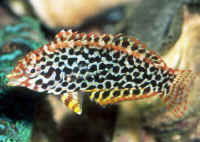
|
|
Genus Novaculichthys: Part of the Razorfishes.
This genus contains the most prominent "Rock
Mover" or Razorfish species, The Dragon Wrasse, N.
taeniourus (formerly in the genus Hemipteronotus). There are
actually a few other genera (e.g. Xyrichthys) and several
species of these specialized, wedge-headed fishes in the Worlds
tropical seas. Most are too plain, or get too rambunctious to be
of interest/use to aquarists. All are prodigious diggers and
movers of decor that need digging room, substrate and well
assembled decor to prevent toppling.
Novaculichthys taeniourus (Lacepede
1801), the Rock Mover, Dragon or Indian Wrasse (2) is a very
hardy fish that is more often killed by aquarists than dies from
other influences. As an aquarium specimen this species requires
regular "beefy" feedings of animal-based foods. It is a
gluttonous feeder that quickly starves if underfed. Not for reef
tanks, Razorfishes are territorial and aggressive fishes. To
about a foot in length. Juvenile in captivity and adult in
Hawai'i shown. One other species in this genus. Not used in
the trade.
|
|
|
Genus Oxycheilinus:
The Maori or Splendour Wrasses, see above under Cheilinus. |
|
Genus
Paracheilinus: The Flasher Wrasses.
|
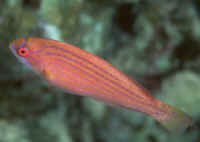
|
|
Genus
Pseudocheilinus: The Lined Wrasses.
|
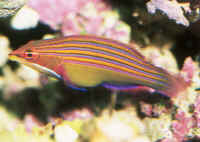
|
| Genus
Pseudocoris: Here: Pseudocoris yamashiroi Schmidt 1931,
The Redspot Wrasse. Western Pacific into Indian Ocean. Indonesia to
perhaps the Mascarenes. To 16 cm. Here in N. Sulawesi. |
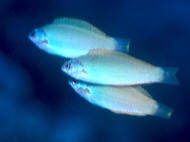 |
Bigger
PIX:
The images in this table are linked to
large (desktop size) copies. Click on "framed"
images to go to the larger size. |
|
%20MD.jpg)
|
|
| Pseudodax moluccanus (Valenciennes 1839), the Chiseltooth
Wrasse. Monotypic. Indo-Pacific; Red Sea to the Tuamotus. Up to a
foot in length in the wild. Occasionally imported for the aquarium
trade, rarely lives due to captive trauma. A juvenile and adult in
the upper Red Sea shown. |
|
Bigger PIX:
The images in this table are
linked to large (desktop size) copies. Click on
"framed" images to go to the larger size. |
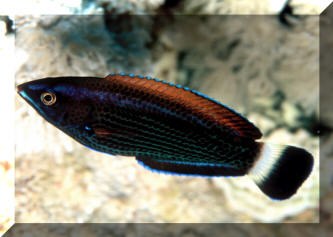 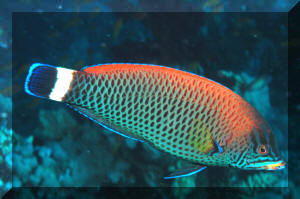 |
|
|
Genus
Pseudojuloides: The Pencil Wrasses.
|
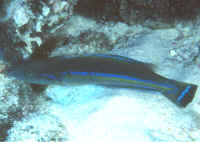
|
| Genus
Pteragogus: Pteragogus cryptus (Valenciennes 1839), the
Cocktail Wrasse. Indo-West Pacific; East Africa to PNG, south to
Australia, north to Japan. To eight inches overall length. This
four inch specimen off Gili Air, Lombok, Indonesia. |
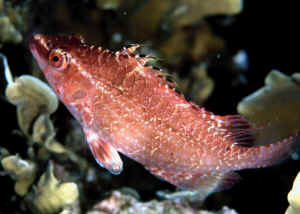
|
|
|
Bigger PIX:
The images in this table are
linked to large (desktop size) copies. Click on
"framed" images to go to the larger size. |
.JPG)
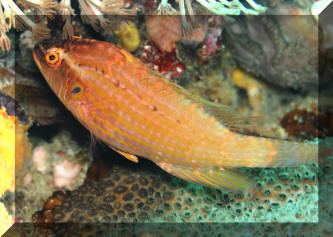 |
|
Semicossyphus pulcher (Ayres 1854), the Sheephead. Both
Californias. One of three temperate species in this genus. Live in
rocky bottom areas, particularly in kelp beds. Males to three feet,
fifty years in age. Female off of San Diego and a two foot male in
a public aquarium. Tow inch juv. below 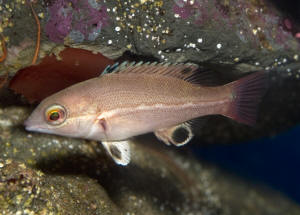 |
|
|
Genus
Stethojulis: The Ribbon Wrasses.
|

|
|
Genus
Thalassoma:
|
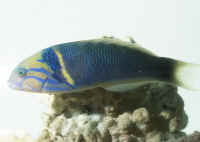
|
|
Wetmorella nigropinnata (Seale 1901), Sharpnose or Possum
Wrasse. One of two species. Indo-Pacific; Red Sea to the Marquesas,
Southern Japan, Micronesia. To three inches in length. Lives in
caves and crannies; secretive species. Feed on small benthic
invertebrates. Aquarium photo. |
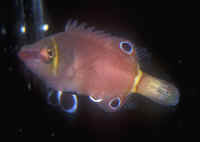
|
| Genus Xyrichthys: The bulk
of Razorfish Wrasses |
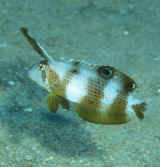
|
In Conclusion:
Can you believe it, this is only a sampling of the family
Labridae! As you can see, the wrasses comprise the full-gamut of
aquarium fish possibilities: meek miniatures to gargantuan giants;
almost filter feeders to algae eaters, plankton and parasite pickers,
to fish-tearers and gulpers; somber hide and seekers, to the boldest
and brightest fishes of the seas. What is germinal in their selection
and care is the same for all-captive livestock selection and husbandry:
knowing what constitutes the best specimens of the right species,
selecting them and meeting their needs.
Bibliography/Further Reading:
Allen, G.R. & J.E. Randall. 1996. Three new species
of wrasses (Labridae: Cirrhilabrus) from Papua New Guinea and
the Solomon Islands. Rev. Fr. Aquariol. 23:101-111.
Baensch, Hans & Helmut Debelius. 1994. Marine Atlas,
v.1. MERGUS, Germany. 1215pp.
Biagi, Mark. 1998. The bluehead wrasse. FAMA 2/98.
Burgess, Warren E. 1977. The dragon wrasse. TFH 8/77.
Burgess, Warren E. 1981. The genus Labroides. TFH
2/81.
Burgess, Warren E., Herbert R. Axelrod & Raymond E.
Hunziker III.1990. Atlas of Aquarium Fishes Reference Book, v. 1 Marine
Fishes. T.F.H. Publications, NJ. 768pp.
Campbell, Douglas. Marines: their care and keeping;
wrasses, parts 1,2. FAMA 12/80, 1/81.
Chlupaty, Peter. 1982. The Hawaiian flame wrasse. TFH
10/82.
Chlupaty, Peter. 1976. The Flame Wrasse. Aquarium Digest
International #15, 76.
Chlupaty, Peter. 1982. The Harlequin Tuskfish,
Lienardella fasciata. TFH 12/82.
Chlupaty, Peter. 1989. The Aqaba red-bellied wrasse,
Cirrhilabrus rubriventralis. TFH 4/89.
Church, James Lee. 1980. The rainbow wrasse,
Thalassoma lucasanum. TFH 5/80.
Edmonds, Les. 1989. Wrasses. FAMA 4/89.
Emmens, Cliff W. 1985. Wrasses. TFH 7/85.
Engasser, Sandy. 1971. Fish of the month; wrasses. Marine
Aquarist 2(4):71.
Esterbauer, Hans. 1992. The twinspot wrasse in nature and
in the aquarium (Coris aygula). TFH 7/92.
Fenner, Robert. 1995. The conscientious marine aquarist;
with notes on cleaner wrasses. TFH 5/95.
Fenner, Robert. 1996. The wrasses we call hogfishes. TFH
10/96.
Fenner, Robert. 1997. The razorfish, family Labridae.
SeaScope v. 14, Fall 97
Fenner, Robert. 1999. The Conscientious Marine Aquarist.
Microcosm, VT. 432pp.
Friese, U.Erich. 1977. Wrasses. Marine Aquarist
7(8):77.
Gonzalez, Deane. 1979. The exquisite Hawaiian Flame
Wrasse. FAMA 6/79.
Giovanetti, Thomas A. 1989. The harlequin tusk: a wrasse
for all seasons. TFH 12/89.
Hoover, John P. 1995. Hawaii's wrasses, parts 1,2.
FAMA 5,6/95.
Howe, Jeffrey. 1992. Original descriptions:
Cirrhilabrus lunatus Randall & Masuda 1991. FAMA 10/92.
Howe, Jeffrey. 1993. Original Descriptions:
Cirrhilabrus lanceolatus Randall & Masuda 1991. FAMA
10/93.
Howe, Jeffrey. 1995. Original Descriptions:
Cirrhilabrus katherinae Randall 1992. FAMA 7/95.
Howe, Jeffrey. 1998. Original descriptions;
Pseudojuloides kaleidos. FAMA 11/98.
Humann, Paul. 1994 (5th ed). Reef Fish Identification.
Florida, Caribbean, Bahamas. New World Publications, Inc. Jacksonville,
FL. 396pp.
Kuiter, Rudie H. & Helmut Debelius. 1994. Southeast
Asia Tropical Fish Guide. Tetra-Press. Melle, Germany. 321pp.
Michael, Scott W. 1990. An aquarist's guide to the
wrasses of the genus Pseudocheilinus.FAMA 9/90.
Michael, Scott W. 1992. Leopard wrasses. SeaScope vol.9,
Spring 92. & AFM 8/99
Michael, Scott W. 1995. Fishes for the marine aquarium,
part 9,10; wrasses- fairy wrasses (Cirrhilabrus); flashers,
lined and Maori. AFM 6,7/95.
Michael, Scott W. 1997. Beautiful wrasses. The unique
species of the genus Halichoeres. AFM 3/97.
Michael, Scott W. 1997. Hogfish. A mysterious common
name. AFM 5/97.
Michael, Scott W. 1997. Fairy Wrasses. You can't go
wrong by choosing among the species in this group. AFM 12/97.
Michael, Scott W. 1998. Wrasses. The good, the bad and
the lovely. AFM 6/98.
Michael, Scott W. 1998. Coris Wrasses; Hardy, but
not for reef tanks. AFM 7/98.
Myers, R.F. 1989. Micronesian Reef Fishes: A Practical
Guide to the Identification of the Coral Reef Fishes of the Tropical
Western Pacific. Coral Graphics, Guam. 298pp.
Parker, Nancy J. 1975. A demon dressed in scales (dragon
wrasse). Marine Aquarist 6(6): 75.
Nelson, Joseph S. 1994. Fishes of the World. 3rd Ed.
Wiley. 600pp.
Privitera, Lisa A. The Hawaiian flame wrasse
Cirrhilabrus jordani Snyder. FAMA 9/92.
Pyle, Richard L. The neon wrasse: Bodianus
sanguineus (Jordan and Evermann). FAMA 12/92.
Randall, John E. 1983. Red Sea Reef Fishes. Immel
Publishing, London. 192pp.
Randall, J.E., G.R. Allen and R.C. Steene. 1990. Fishes
of the Great Barrier Reef and Coral Sea. University of Hawai'i
Press, Honolulu. 507pp.
Randall, J.E. 1992. A review of the labrid genus
Cirrhilabrus from Japan, Taiwan and the Mariana Islands, with
descriptions of two new species. Micronesica 25(1):99-121.
Randall, John E. 1996 (3d ed.). Caribbean Reef Fishes.
T.F.H. Publications, NJ. 368pp.
Randall, John E. 1996 Shore Fishes of Hawai'i.
Natural World Press, OR. 216pp.
Scheimer, Gregory. 1997. Wrasses for the reef aquarium,
pt.s 1,2. FAMA 11,12/97.
Stratton, Richard F. The red wrasse: Coris
gaimard. TFH 11/89.
Stratton Richard F. 1990. The Hawaiian saddle wrasse. TFH
6/90.
Stratton, Richard F. 1991. The sunset wrasse
(Thalassoma lutescens). TFH 6/91.
Stratton, Richard F. 1993. The Spanish hogfish. TFH
4/93.
Stratton, Richard F. 1996. The broomtail wrasse. TFH
7/96.
Stratton, Richard F. 1997. The twinspot Maori wrasse. TFH
7/97.
Takeshita, Glenn Y. 1977. Hawaiian flame wrasse. TFH
7(8):77.
Tepoot, Pablo & Ian. 1996. Marine Aquarium Companion
(Southeast Asia Volume). New Life Publications, Homestead FL.
358pp.
Thresher, Ronald. 1977. Caribbean wrasses. Marine
Aquarist 8:2,77.Weingarten, Robert A. Sexual/reproductive patterns in
Caribbean wrasses (Labridae). FAMA 12/91.
Westneat, M.W. 1993. Phylogenetic relationships of the
tribe Cheilini (Labridae: Perciformes). Bull. Mar. Sci.
52(1):351-394.Young, Forrest A. Artificial propagation of Spanish
hogfish (Bodianus rufus). FAMA 10/93.

